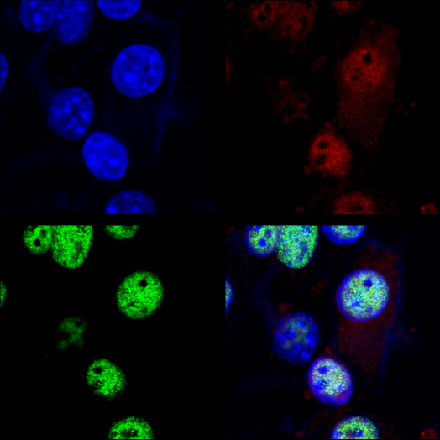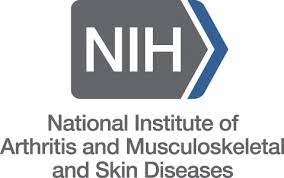Importance of Transition Metals in Mammalian Development
The Lab
Transition metals and cell differentiation
My lab is investigating the biological roles of transition metals, such as Cu, Zn, Co, and Mn, in the development of mammalian cells. Metals play many critical roles in biology as cofactors for a variety of enzymes that are necessary for energy production, tissue maturation, signal transduction and oxidative stress resistance. Metal homeostasis requires chelation by high-affinity binding molecules, transport and sensing by transcriptional regulators to maintain low levels of free metals, as free metals participate in different toxic reactions. How organisms acquire these micronutrients and distribute them to specific cellular compartments or target proteins are subjects of intense scientific interest. Moreover, little is known about how metals and the proteins that handle and distribute them participate in processes that regulate normal growth and development. Eukaryotic genomes encode a wide variety of metal transporters and metalloproteins. Although their biochemical and metal binding properties are relatively well understood, little is known about the fine-tuned regulation of their expression, specificity for metal transport, and the redundancy of functions in the context of cell differentiation and development.
Research Focus
Copper: one ion, different cellular destinations

My lab conducts systematic studies that combine a variety of molecular and cell biology techniques into biological models, including established cell lines and primary cultures. We incorporate diverse biochemistry techniques and combine with high resolution cutting edge synchrotron-based X-ray fluorescence spectroscopy. In particular, we study skeletal muscle differentiation as muscle present an elevated intrinsic need for transition metals like Cu for proper function. This ion is required for mitochondrial energy production as a fundamental component of cytochrome c oxidase which is elevated during the course of differentiation. We hypothesize that the proper cellular distribution of Cu+ has a leading role in the differentiation of the muscle lineage. We have evidence that support different cellular roles for Cu in addition to energy production. Moreover, we hypothesize that diverse devastating myopathies are associated with Cu deficiencies at different levels, from mitochondrial Cu-transport and function to general cellular failure in Cu homeostasis and gene regulation. We hope to provide novel molecular mechanisms that help to understand the basis of muscular phenotypes observed in mitochondrial myopathies and also in Menkes’ and Wilson’s disease patients.
Publications

Latest publications from the lab:
Muscle-Specific Pyruvate Kinase Isoforms, Pkm1 and Pkm2, Regulate Mammalian SWI/SNF Proteins and Histone 3 Phosphorylation During Myoblast Differentiation. 2024. Monserrat Olea-Flores, Tapan Sharma, Odette Verdejo-Torres, Imaru DiBartolomeo, Paul R. Thompson, Teresita Padilla-Benavides, Anthony N. Imbalzano. Biorxiv; https://www.biorxiv.org/content/10.1101/2024.04.10.588959v1
Single nucleotide polymorphisms and Zn transport by nuclear ZIP11 shape cancer phenotypes in HeLa cells. 2024. Elizabeth Y. Kim, Odette Verdejo-Torres, Karla Diaz-Rodriguez, Farah Hasanain, Leslie Caromile, Teresita Padilla-Benavides*. Biorxiv; https://doi.org/10.1101/2023.08.12.553076. Metallomics, mfae006. https://doi.org/10.1093/mtomcs/mfae006
Differential requirements for different subfamilies of the mammalian SWI/SNF chromatin remodeling enzymes in myoblast differentiation. 2023. Teresita Padilla-Benavides*, Monserrat Olea-Flores, Tapan Sharma, Sabriya A. Syed, Hanna Witwicka, Miriam D. Zuñiga-Eulogio, Kexin Zhang, Napoleon Navarro-Tito, Anthony N. Imbalzano*. International Journal of Molecular Sciences. 24 (14), 11256; https://doi.org/10.3390/ijms241411256
Functional effect of indole-3 carbinol in the viability and invasive properties of cultured cancer cells. Andrea S. Baez-Gonzalez, Jaime A. Carrazco-Carrillo, G. Figueroa-Gonzalez, L.I Quintas-Granados, Teresita Padilla-Benavides*, and Octavio Reyes-Hernandez*. 2023. Biochemistry and Biophysics Reports, Latin America special edition. https://doi.org/10.1016/j.bbrep.2023.101492
Heterogenous nuclear ribonucleoprotein (hnRNP) A2/B1 regulates the abundance of the copper-transporter ATP7A in an isoform dependent manner. 2022. Cat McCann, Nesrin M. Hasan, Teresita Padilla-Benavides, S. Roy, and Svetlana Lutsenko. Frontiers in Molecular Biosciences – Cellular Biochemistry. Research topic: Novel Approaches to Study Metals in Molecular Biology
The Oncopig as an emerging model to investigate copper regulation in cancer. 2022. Alyssa Carlson, Jaime Carrazco-Carrillo, Aaron Loder, Lobna Elkhadragy, Kyle M. Schachtschneider, and Teresita Padilla-Benavides*. International Journal of Molecular Sciences. 23 (22), 14012. https://doi.org/10.3390/ijms232214012
The mitochondrial Cu+ transporter PiC2 (SLC25A3) is a target of MTF1 and contributes to the development of skeletal muscle in vitro. 2022. Cat McCann, Michael Quinteros, Ifeoluwa Adelugba, Marcos N. Morgada, Aida R. Castelblanco, Emily J. Davis, Antonio Lanzirotti, Sarah J. Hainer, Alejandro J. Vila, Juan G. Navea, Teresita Padilla-Benavides*. Frontiers in Molecular Biosciences – Cellular Biochemistry. Research topic: Novel Approaches to Study Metals in Molecular Biology. https://doi.org/10.3389/fmolb.2022.1037941
Oxidative reactions catalyzed by hydrogen peroxide produced by Streptococcus pneumoniae and other streptococci cause the release and degradation of heme from hemoglobin. 2022. Babek Alibayov, Anna Scasny, Faidad Khan, Aidan Creel, Perriann Smith, Ana G. Jop Vidal, Fa’alataitaua M. Fitisemanu, Teresita Padilla-Benavides, Jeffrey Weiser, and Jorge E. Vidal. https://doi.org/10.1128/iai.00471-22
Surface tension of model tissues during malignant transformation and epithelial–mesenchymal transition. Irène Nagle, Alain Richert, Michael Quinteros, Sébastien Janel, Henry Debost, Véronique Thevenet, Claire Wilhelm, Céline Prunier, Frank Lafont, Teresita Padilla-Benavides, Mathieu Boissan, Myriam Reffay. 2022. Frontiers in Cell and Developmental Biology. Cell Adhesion and Migration section. Special topic on Mechanical and Structural Phenotypes of Cells and Extracellular Matrices Govern Cell Adhesion and Migration. https://doi.org/10.3389/fcell.2022.926322
ZIP11 Regulates Nuclear Zinc Homeostasis in HeLa Cells and Is Required for Proliferation and Establishment of the Carcinogenic Phenotype. 2022. Monserrat Olea-Flores, Julia Kan, Alyssa Carlson, Sabriya A Syed, Cat McCann, Varsha Mondal, Cecily Szady, Heather M Ricker, Amy McQueen, Juan G Navea, Leslie A Caromile, Teresita Padilla-Benavides*. Frontiers in Cell and Developmental Biology. Cellular Biochemistry section. Special topic on Bioinorganic Chemistry of Metals in Cell Function and Disease. https://doi.org/10.3389/fcell.2022.895433
Differential requirements for different subfamilies of the mammalian SWI/SNF chromatin remodeling enzymes in myoblast cell cycle progression and expression of the Pax7 regulator. Teresita Padilla-Benavides*, Monserrat Olea-Flores, Yaje Nshanji, May T. Maung, Sabriya A. Syed, and Anthony N. Imbalzano. 2022. BBA – Gene Regulatory Mechanisms. https://doi.org/10.1016/j.bbagrm.2022.194801
The mitochondrially-localized nucleoside diphosphate kinase D (NME4) is a novel metastasis suppressor. Marie-Lise Lacombe, Frederic Lamarche, Olivier De Wever, Teresita Padilla-Benavides, Alyssa Carlson, Imran Khan, Anda Huna, Sophie Vacher, Claire Calmel, Céline Desbourdes, Cécile Cottet-Rousselle, Isabelle Hininger-Favier, Stéphane Attia, Béatrice Nawrocki-Raby, Joël Raingeaud, Christelle Machon, Jérôme Guitton, Morgane Le Gall, Guilhem Clary, Cedric Broussard, Philippe Chafey, Patrice Thérond, David Bernard, Eric Fontaine, Malgorzata Tokarska-Schlattner, Patricia Steeg, Ivan Bièche, Uwe Schlattner, and Mathieu Boissan. 2021. BMC Biology. 19: 228. https://doi.org/10.1186/s12915-021-01155-5
Molecular basis of copper dysregulation and its relationship with human pathologies. May T. Maung, Alyssa Carlson, Lobna Elkhadragy, Kyle Schachtschneider, Napoleon Navarro-Tito, and Teresita Padilla-Benavides*. 2021. FASEB Journal. 35: e21810. https://doi.org/10.1096/fj.202100273RR
Impact of professional and scientific societies’ student chapters on the development of underrepresented undergraduate students. Lily Barnes, Joshua Grajales, Jocelyn Velasquez Baez, Daniel Hidalgo and Teresita Padilla-Benavides*. 2021. Frontiers in Education. https://doi.org/10.3389/feduc.2021.763908
Wesleyan undergraduate and graduate students
Funding

1R01AR077578-01A1 Mechanisms of Cu-binding factors to promote myogenic gene expression

